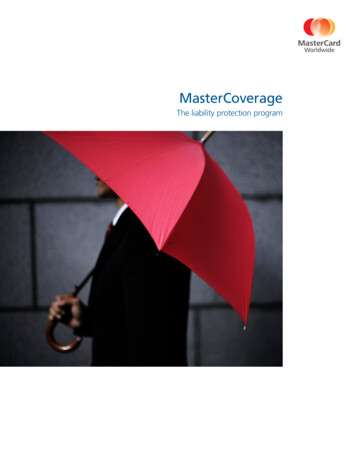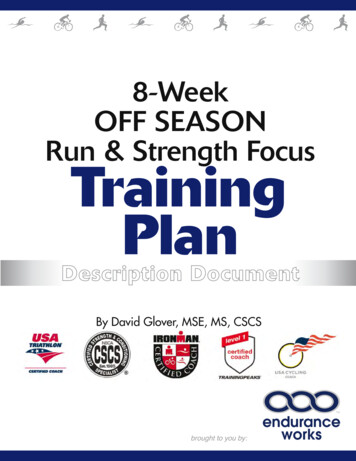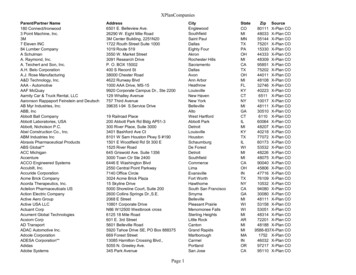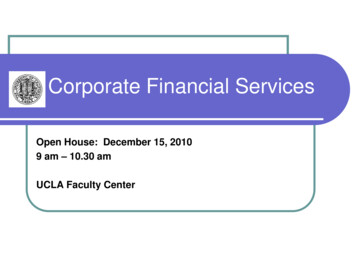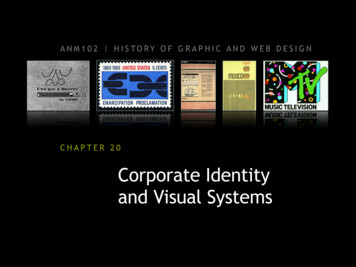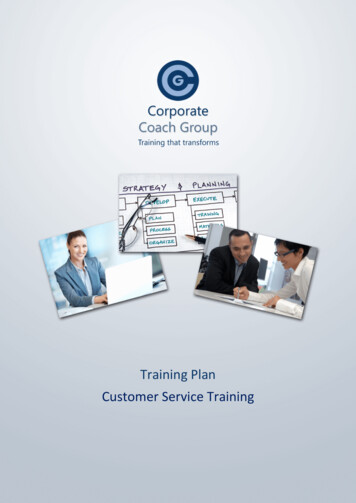
Transcription
Training PlanCustomer Service Training
Training PlanCustomer Service TrainingA Training Plan for Your OrganisationWhat is the purpose of the training?The purpose of the training is to initiate a process of rapid improvement, by means ofachieving a shared understanding of the correct knowledge and skills that we need to employ,if we are to achieve our stated goals.Customer Service Course SummaryCustomer service is essential because every organisation needs the continued support of itscustomers. Whenever clients lose faith in the willingness of organisations to give goodservice, they find alternative suppliers. To live long and prosper, every organisation needs tomaster the art of customer service.This one-day course teaches customer service by breaking it into three parts: A model thatdescribes the process of Excellent Customer Service; Special Communication skills; Howattitudes affect customers.Learning Outcomes for the Customer Service Course Master the six steps of great Customer ServiceGive a friendly greeting and introductionAccurately analyse your customers’ individual needsGive a professional presentation of your product or serviceAgree specific actionsProvide a prompt delivery of your product and serviceWin more business by making a request for a referred leadCustomer Review“I felt the course content was very useful and interesting to learn varioustechniques/situations to put into practise in my job role. The trainer’s presentation wasvery clear and understanding, a nice interaction with all the group, with gentle humouradded in.Vicky WhiteThe Highways AgencyPage 2
Training PlanCustomer Service TrainingCustomer Service Training Course OverviewWe have divided the course into three parts: the excellent customer service process,customer service communication skills and customer service attitudes.The customer service process is itself made up of: introduction, empathy, investigation,proposed solution, confirmation, close. You will learn the skills relating to each of these parts.Communication skills consists of: words/ phrases we should use, words/ phrases we shouldnever use, correct voice tones, the importance of good accurate notes.Customer service attitudes: How attitudes can help or hinder customer service. How to keep apositive attitude, even on tough days.When people finish this training, they are fully equipped to deliver excellent customer service.Which is good for you, good for them and good for the organisation.Customer Review“The course content was very useful, exactly what I was looking for. Encouraged thoughtand methods to take back to the workplace. The trainer’s presentation was very clear,Chris not only delivers the training but stands behind his methods and believes in thecontent.Tony StuchfieldPrimecarePage 3
Training PlanCustomer Service TrainingCustomer Service Training Course DetailsMorning SessionIntroduction to Customer Service TrainingCustomer service is important because people respond emotionally to every aspect of yourproduct or service. You need to be able to create a lasting positive impression in the mind ofyour customer, whilst at the same time, building your business.What is the customer service experience?There are six parts to the customer service experience: Greetings and introductionAnalysis of customer needsPresentation of product and serviceClose to actionDelivery of product and serviceAfter sales service and request for referralPage 4
Training PlanCustomer Service TrainingGreetings and introductionFirst impressions do count. First impressions set the scene for the relationship.Once a person has made up their mind about someone, then they tend to engage in a processof selective perception, whereby they will tend to gather supporting evidence to justify theoriginal impression.For instance, if on meeting someone, you form a bad first impression based on somethingthey say, or do, then you tend to see other bad things and you downgrade any good thingsthey may do.If you form a good first impression, then you tend to see other good things they do and youexcuse the bad things they may do.People do “judge books by their covers”People do make emotional judgements of others, based upon what they see and hear.People will judge you by everything you say and everything you do, as well as everything youfail to say and everything you fail to do.For instance: When you smile, and say "good morning", that says one thing.If you don't smile, and you fail to say "good morning", then that says another thing.Elements of first impressionsWhat you should do in the first few minutes of meeting someone? Visual - what they seeSound - what they hearEmotions - how they feelPage 5
Training PlanCustomer Service TrainingAnalysis and investigation of customer needsWhen you meet someone your overarching principle is this:How can your products and services be of genuine assistance to make this person’s lifebetter?In order to help someone, you need to keep your eyes, ears, and mind open. Ask them questions about what they have now.Ask them questions about what they would like, or need in the future.The difference between what the customer has now and what the customer would like in thefuture, is the way you can add value to the customer.It is your opportunity to help them and your business, at the same time.Success is essentially simpleTo succeed you need to find ways to make your customers lives better.You do that by finding ways you can add value to them.You do that by providing them with your skills, knowledge, products and services.Communication: The proper use of languageHow can you gain a mutual understanding and a sense of cooperation? By your use of theright words.Five polite phrases you need to use as a speech habit:1.2.3.4.5.Yes, please.No, thank you.Would you mind if we .?Would you please .?Thank you very much, I appreciate it.In addition, show genuine interest in anything of note.Page 6
Training PlanCustomer Service TrainingAvoid the bad use of wordsAny form of profane language.Moaning, whining and complaining about anything.Complaining to your customer about other parts of your business. The office staff, themanagement, etc. Anything which may create a negative thought in the mind of thecustomer.For example, if the customer ever thinks: They don’t care about me.How long is this going to take?This person is rude!Then your chances of pleasing your customer are gone.Page 7
Training PlanCustomer Service TrainingAfternoon SessionCommunicationTones: Pace and intensity of the messageSpeed: how much information can you give to someone before they become confused? It isan error to give too much information, too quickly.Intensity of your own emotionAny expression of annoyance, anger, frustration or bad mood will trigger a negative customerresponse in return.Body language Dress code: what you are wearing and how it looks.Posture: how you stand, or sit.Touch: HandshakeTouch: Any other form of touch, other than handshakeHand and arm gesturesEye contactFacial expressionProximity (personal space)Body odourScent / breath. Be wary of: coffee, cigarettes, alcoholPhysical surroundings must create a positive emotion1.2.3.4.5.6.7.8.9.Tools and equipmentAccessories and badges etcVehicleToolsEquipmentAccessoriesBusiness cardsPaperwork and contractsOthersPage 8
Training PlanCustomer Service TrainingPoliteness, proper sense of humour and good sense of etiquetteHumour is a double-edged sword: Amusing with a nice sense of humour.Silly and a bit of a clown, or a joker.Timeliness and its effect on the mind of the othersIf you are inexplicably late or slow, then it makes a big dent in the mind of your customer. Youneed to be on time, or at least keep them informed of any changes in your arrival time.Time is precious.ProfessionalismWhat does the term professional mean to you?What are the six key distinguishing characteristics that separate a professional attitude, froma non-professional d listenerFriendlyConsistentAsk for referralsIn order to build the business, we would like more customers. And we can get morecustomers by gaining referrals.A referred lead is when someone recommends a product or service to a friend or a colleague,based upon a personal experience.Remember this: Everyone knows someone who needs your products or service. If you ask for referrals, then you may get one.If you don't ask them, then you won’t.You need to find a way to gain more referrals.Page 9
Training PlanCustomer Service TrainingReferrals should come at the successful completion of the task and when the customer ispleased with the service you have given.Summary and Action PlanPage 10
Training PlanCustomer Service TrainingTraining Costs / InvestmentBespoke In-House or Live-Online Course 1,950 VAT per training dayPlus, hotel accommodation for trainer if needed (Premier Inn type: not the Hilton!)(International Price Varies)In-House training has been designed to provide a similar experience to our open courses,however we can tailor the content to fit your specific needs.We are able to train in your timezone.All our training includes: A full day of quality training, delivered by an experienced trainerTotal of 6 CPD training hours (usually 9am - 4.30pm), plus an additional 2-3 via postcourse online independent learningFull digital interactive course notesTraining certificateAccess to additional free training material after the course via our post-course portal3 months free telephone coaching: Whilst you are implementing what you havelearned, if you need to, you can contact us for support and guidanceWe suggest the following plan of action:Please send to us:1. Any amendments or changes you wish to make to the programme.2. Your thoughts.3. The next step you would like us to take.Thank you.Corporate Coach Training LtdWalcot HouseParton RoadChurchdownGloucestershireGL3 2JJEmail: lindsey@corporatecoachgroup.comTel: 44 (0) 1452 856091Page 11
Training PlanCustomer Service TrainingCustomer Reviews“I thoroughly enjoyed the course, especially the area of prioritising my work andnot letting other people’s actions determine how my day goes. Excellentcontent. The training presentation was very good and the models and diagramswere very helpful in making things and ideas easier to understand/grasp.Ayum EttaNiger Delta Development Commission“The course was well structured with a good flow of topics which led onto thenext topic. I liked the interactive part, working with the other attendees. Thankyou for delivering a course with NO power point slides. It was really refreshing.The trainer’s presentation was excellent! Informative, engaging, veryknowledgeable and the real-life examples were excellent.Pam HolleyRWE Supply and Training“Broad content covered at speed, but with practical and helpful reference to realworld experience. Provoked thought about positive actions to take in myworkplace, for both myself and others. The trainer’s presentation was positive,with a vibrant delivery style. Kept attention and focus.John MahoneyYamaha Music Europe Ltd“Training course content was very useful in putting logical structures aroundcommon problems and ways of thinking. Good balance of verbal and visualmaterial. Good delegate interaction without pressure. Trainer’s presentation wasvery engaging with infectious energy and just the right amount of humour.Rob HamblingNHS Western CheshirePage 12
Customer Service Training Page 3 Customer Service Training Course Overview . We have divided the course into three parts: the excellent customer service process, customer service communication skills and customer service attitudes. The customer service process is

